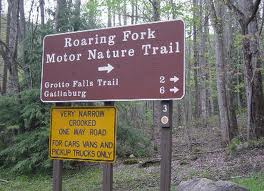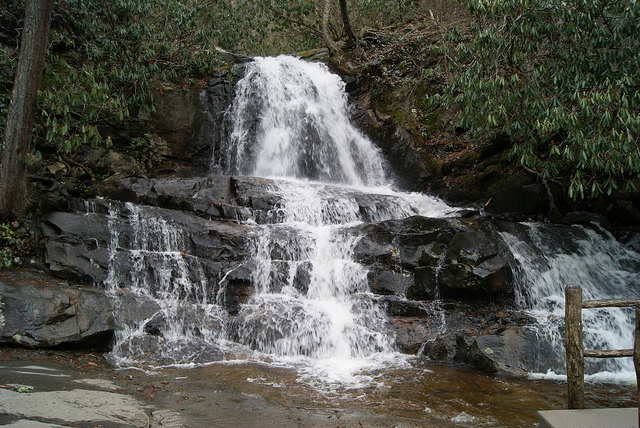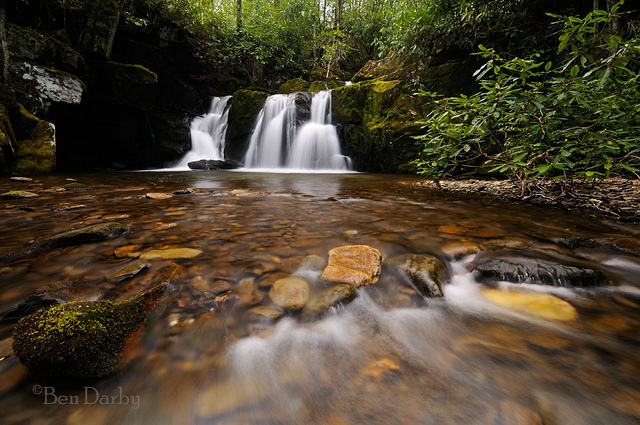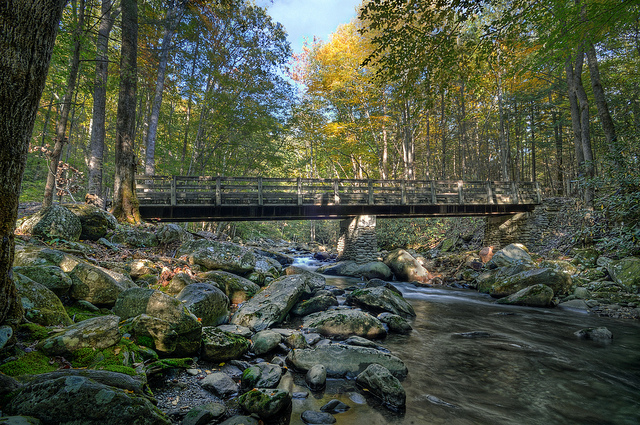Elkmont, situated in the upper Little River Valley of the Great Smoky Mountains, is but a shell of what it once was – an early 20th Century social getaway to Knoxville’s elite. Today, a literal ghost town is all that remains.
 At times in the Great Smoky Mountain National Park it is hard to imagine what the area was like before it became one of our national treasures. Truth be told, the land that is now in the National Park contained industry, business and homes before it became part of the National park Service 80 years ago. One of the places in the Park that makes it easy to see what life was like ‘before the Park’ is Elkmont. Currently Elkmont is home to a campground, fishing areas and hiking trails, but its history goes back much further. Starting as a small settlement in a valley, and changing with the times, it became a center for the logging industry, finally to become a resort town nestled in the Smoky Mountains. With the National Park movement in the 30s, Elkmont was purchased and became part of the Great Smoky Mountain National Park. With the leases in Elkmont expiring, the buildings were left where they stand to this day; a monument to the past and a ghost town in the Smokies.
At times in the Great Smoky Mountain National Park it is hard to imagine what the area was like before it became one of our national treasures. Truth be told, the land that is now in the National Park contained industry, business and homes before it became part of the National park Service 80 years ago. One of the places in the Park that makes it easy to see what life was like ‘before the Park’ is Elkmont. Currently Elkmont is home to a campground, fishing areas and hiking trails, but its history goes back much further. Starting as a small settlement in a valley, and changing with the times, it became a center for the logging industry, finally to become a resort town nestled in the Smoky Mountains. With the National Park movement in the 30s, Elkmont was purchased and became part of the Great Smoky Mountain National Park. With the leases in Elkmont expiring, the buildings were left where they stand to this day; a monument to the past and a ghost town in the Smokies.
The Elkmont area was originally settled by two Smokies families in the 1840s, at least one of which came to the area to look for gold. Like most small mountain communities they were subsistence farmers that produced everything from corn to honey to make ends meet and put food on the table. The creek that runs along the Elkmont Trail is Jake’s Creek, named for Jacob Hauser, probably the first settler to this area. From this time period, the only existing structure is the Avent Cabin which was built around 1845 by the Ownby family.
 John English, a Knoxville, Tennessee businessman, began a small-scale logging project in the Elkmont area along Jake’s Creek. This business venture started the logging period for the Elkmont area but it was a Pennsylvania native, Colonel Wilson Townsend (after whom Townsend TN is named) that established the Little River Lumber Company. Townsend setup a railroad that went from his saw mills to the logging camp in what became known as Elkmont to the loggers. The Elkmont area was used as the base of operation for the lumber company through the 20s and 30s. By this time Townsend had sold most of the land to the newly formed national Park. But let’s not get ahead of ourselves…
John English, a Knoxville, Tennessee businessman, began a small-scale logging project in the Elkmont area along Jake’s Creek. This business venture started the logging period for the Elkmont area but it was a Pennsylvania native, Colonel Wilson Townsend (after whom Townsend TN is named) that established the Little River Lumber Company. Townsend setup a railroad that went from his saw mills to the logging camp in what became known as Elkmont to the loggers. The Elkmont area was used as the base of operation for the lumber company through the 20s and 30s. By this time Townsend had sold most of the land to the newly formed national Park. But let’s not get ahead of ourselves…
Townsend noticed that as the forest was being mined for its valuable resources that he could use the train to bring hunters and fishermen to the area. The railroad reached Maryville and Knoxville by 1909 and they began offering the “Elkmont Special.” This special was train service from Knoxville to Elkmont. Tickets on the Elkmont special became a hot commodity. Soon a bigger engine was added and in 1912 Charles Carter built the Wonderland Hotel – a 50 room resort lodge overlooking Elkmont. In 1914 a group of citizens from Knoxville formed the Appalachian Club. This ‘club’ built 40 or more rustic cabins and a lodge. The Elkmont area became the place for Knoxville’s elite to go. Membership into the Appalachian Club was hard to acquire. Even the removal of the railroad to another logging area did not deter the members, who, along with the help of Tennessee Governor Austin Peay, put in a road connecting Townsend and the Elkmont area.
By this point in history, National Parks like Wyoming’s Yellowstone started opening across the country. The idea to open a National Park in the Smokies may have even started with one of the members of the Appalachian Club. Whoever originally came up with the idea, in 1926 Colonel Townsend sold the initial 76,000 acres to start the Great Smoky Mountains National Park Park. Even though the national park would be a great addition to their community, the cottage owners and members of he Appalachian Club were losing their summer homes, their vacation spot. With the help of an attorney from the Little River Lumber Company they were allowed to sell their property at half price and get a lifetime lease. Most of the lifetime leases expired in 1992 with the last two expiring in 2001. The 1982 General Management Plan of the Great Smoky Mountain National Park called for the structures to be removed and the land would be allowed to revert to its natural state. In 1994, just a mere two years after most of the leases had expired, this plan was overridden when Elkmont was placed on the National Register of Historic Places, saving the cottages from destruction. Unfortunately, though they were saved from removal, they were left to deteriorate. The Park Service did not have the means or extra funding to preserve those buildings. The Wonderland Hotel collapsed in 2005 and has since been removed, though some of the historical fixtures and items from the hotel have been preserved. The homes along Little River and Jake’s Creek were also left to the elements, without upkeep.
 At the time of this writing, there is sign of reconstruction going on in Elkmont. Some new porches and construction tape now adorn some of the cabins and cottages. According to a brief sent out from the Park Service in the fall of 2007, they are proposing that 19 of the remaining buildings be preserved. This preservation effort would include the Appalachian Clubhouse and other buildings of historic significance. This move is still waiting for approval but it is certainly a positive step to preserve some of the pre-park history.
At the time of this writing, there is sign of reconstruction going on in Elkmont. Some new porches and construction tape now adorn some of the cabins and cottages. According to a brief sent out from the Park Service in the fall of 2007, they are proposing that 19 of the remaining buildings be preserved. This preservation effort would include the Appalachian Clubhouse and other buildings of historic significance. This move is still waiting for approval but it is certainly a positive step to preserve some of the pre-park history.
Since then, the National Park Service in 2009 announced plans to restore the Appalachian Clubhouse and 18 cottages and outbuildings in the Appalachian Club area (which were older and more historically significant) and remove all other structures, including the Wonderland Annex which had collapsed in 2005.
Maybe this ghost town in the Smokies will receive some tender loving care, bringing back that Smoky Mountain vacation spot atmosphere that it had so many years ago.
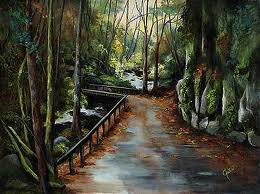 The people that made their homes in the Roaring Fork area were a hardy bunch. Instead of choosing the easier life in the valleys –Cataloochee and Cades Cove – the people that settled these areas were looking for homes in the woods on top of the mountains. They built their community along the streams where the rushing water could be harnessed and used to power water wheels that would grind grains and help with cutting lumber into usable boards. They had full service farms that were designed to keep their family going but they also had other industries that keep them busy during the off times of the year.
The people that made their homes in the Roaring Fork area were a hardy bunch. Instead of choosing the easier life in the valleys –Cataloochee and Cades Cove – the people that settled these areas were looking for homes in the woods on top of the mountains. They built their community along the streams where the rushing water could be harnessed and used to power water wheels that would grind grains and help with cutting lumber into usable boards. They had full service farms that were designed to keep their family going but they also had other industries that keep them busy during the off times of the year.